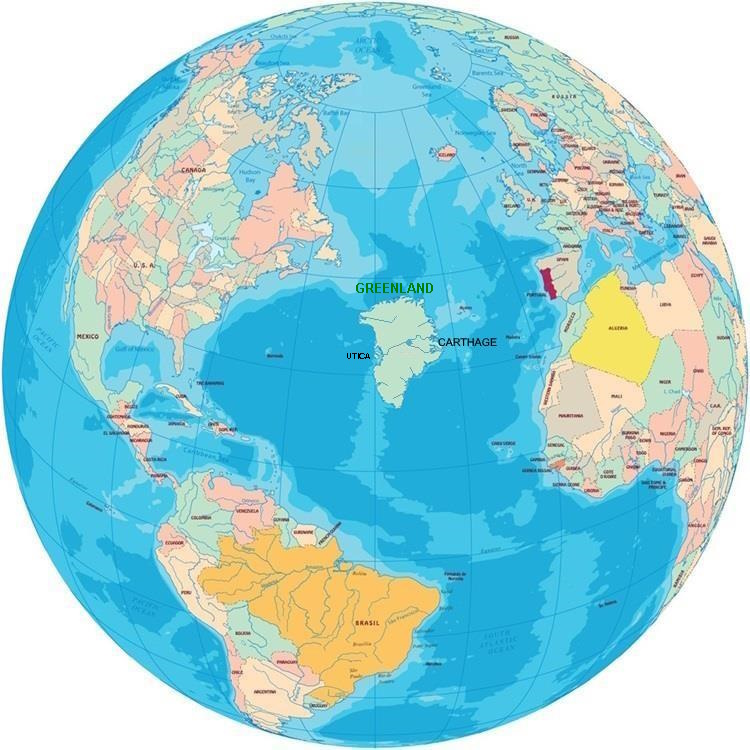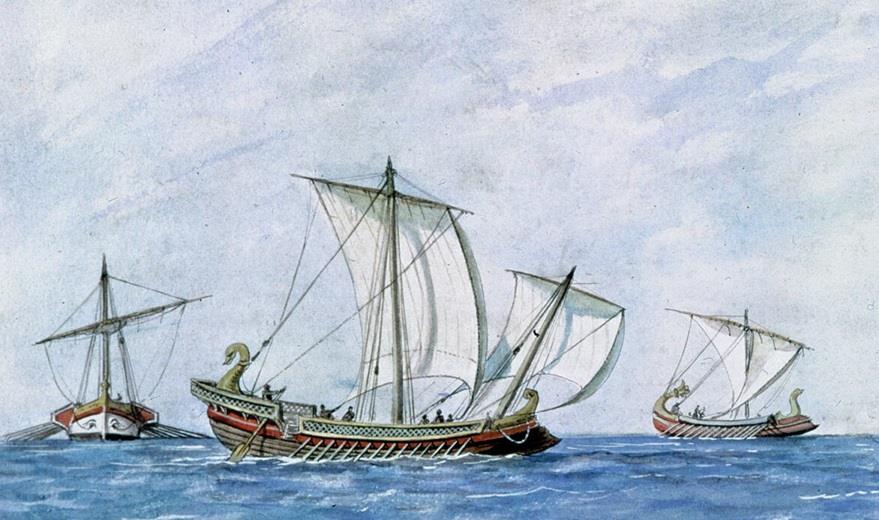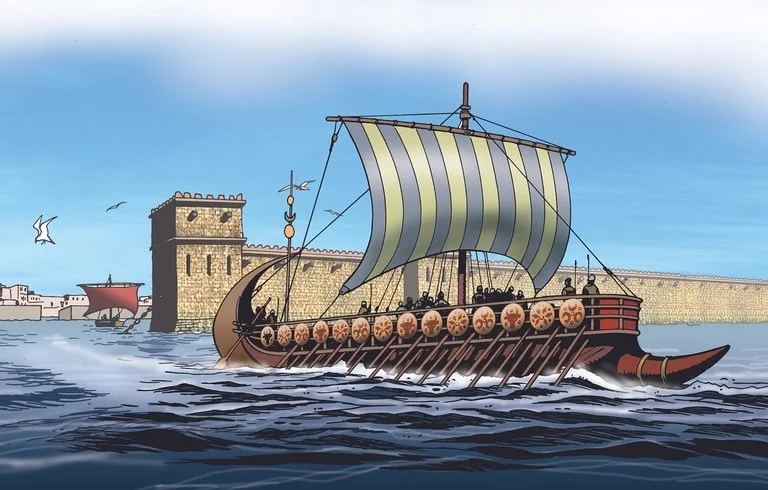
Royal Greenland Navy
200 million years ago, what we know as 'Greenland' detached itself from the
American Tectonic plate and set sail down the length of the Atlantic like a
gigantic iceberg. The worlds oceans were going through a high cycle and
Greenland did not touch ground until it hit the mid-Atlantic ridge which snagged
the island and held it in place until water levels lowered again and Greenland
settled in its new home.

Greenland was first discovered by the Egyptians when they ventured out past the
Pillars of Hercules in search of Atlantis. While they may never have discovered
Atlantis, Greenland was a pretty good second best. While the information was
returned to the Empire, the latest Pharaoh was dethroned by the Hyksos shortly
thereafter and lost with the sacking and destruction of the Great Library of
Alexandria. Next in line were the seafaring explorers of Carthage, who ventured
beyond the Pillars of Hercules as an escape from the persecution of the Romans.
Five galleys of men, women and children of Carthage landed on Greenland in
150BC and named their new land 'Greenland' because as far as the eye could see
was green fields and streams. The new city,
Kart-hadasht, was slowly being established when news was brought by a trader
that Carthage had fallen to the Romans and been destroyed. To honour their
homeland the new city was renamed Carthage in 145BC. (Note - 'Carthage' is the
Roman name and the name used most so I will continue with that name) 140BC and a
set of Roman galleys arrived in Greenland waters and were met with superior
force by the Carthaginian Fleet that had been expecting them. No galley was
spared and any Roman who would not surrender was slaughtered. No news returned
to Rome who forgot about it as they were having enough problems in other parts
of the Empire much closer to home. Explorers followed the river, New Carthage
was founded alongside, into the interior and discovered a Great Lake that had
two mighty rivers feeding from it, the one they had followed from Carthage and
another that terminated on the West coast of Greenland. Where the river came
out, a new city was founded, Utica. Greenland did not want news of its verdant
lands and mighty opportunities being told throughout Europe as the pirates and
freebooters would try to sack Greenland. So the Greenlandian Navy made sure that
any boats arriving in Greenland's waters did not leave. Their goods and people
being absorbed into the new Empire. The Empire was a 'slave' economy. In the
original galleys, the oarsmen had been slaves and the families aboard had
slaves. The captured Romans became slaves, and any captured traders joined the
slave trade. The unruly slaves were worked to death creating the new trappings
of Empire. Roads, buildings, aqueducts, housing, sanitary systems, all were
built with slave labour. New slaves being required as the Empire grew. The
required slaves were available along the coasts of Central Africa, and many
raids were undertaken by the Navy to provide them for the Empire. Breeding from
the female slaves helped but was not fast enough to keep up with demand.

Hundreds, then many hundreds of years passed with the Greenlanders slowly
inhabiting all the best bits of their land. The two great cities being the focal
points of the Empire, while smaller towns and outposts were created on the trade
routes to protect the passage of goods and material from one end of the Empire
to the other. Roads were built by slave labour connecting all the towns and
cities to aid the passage of goods and information.
The political scene for Greenland started out with a similar layout to the
original Carthage with two Judges at the top passing or denying the laws given
to them by the lower level of Senators. With only a few hundred people to start
the new Empire, this was replaced with an elected 'King/Queen' who would rule
and be replaced every 5-10 years, depending on his/her productivity for the
country. If you were really slack the noble houses may have you killed and
replaced even earlier. The first King was a relative of Queen Dido and proved to
be very good in his ten years of service to the Empire. It was his directives
that got the ball rolling for all the projects that would need to be done to
create a stable Empire.
So a King at the top, then Noble houses that provided the high level officers
for the Army and Navy, and the support for the King. The lower houses and
Greenlanders populated the Sergeant/Petty officer levels and the lowest castes
of true Greenlanders the troops and seamen. Slaves would be used for any of the
grunt work or cannon fodder jobs to be done. The slaves would be kept away from
weapons to keep ideas of revolt out of their heads. Death for a slave was never
far away if any sign of revolt was shown. As the years went by many slaves
earned manumission and became full members of the Empire. The women who obtained
manumission had no trouble in finding husbands as there was a long time shortage
of women in the Empire. This was slowly righted by the acquisition of slaves
from the surrounding lands that could be 'bought' by the lower castes to become
wives and help to increase the population. It all took time. During this period,
the Navy was the Senior Service. It was needed to intercept any shipping that
may arrive in Greenland's waters. The Army had an Elite force that was used for
hunting down escaped slaves or survivors of sunk ships that might make it to
shore. Recaptured slaves were killed, captured survivors became slaves.

Exploration to the West brought back slaves. It was found the men were useless
as general slaves and were chained to oars as their life sentence. The women
proved extremely valuable, but it was the strange four legged beasts known as
horses that became some of the most valuable commodities in the Empire. It was
decreed that all horses would belong to the King until such time as there were
enough to go around. It was made a priority to source more of these beasts. A
General of Horse was created to train not only the horses but to train the
'horsemen' as well. This cavalry force would become the Elite unit of the Army
and the Noble Houses would vie with each other to have as many of their sons as
possible in this Elite unit. As more horses became available, more duties were
found for them. One of the most important was as messengers around the Empire.
From weeks to get to one end to the other on foot it was now measured in days on
horseback.
We have arrived at the point of 'European' exploration, with the exploits of the
great explorers now under scrutiny. Cristoforo Colombo may have been the first
'modern European' to discover North America, he was not the first by any stretch
of the imagination. People from Greenland got there in 650-700 AD, the Norse in
900-1000 AD. Columbus was a Johnny come lately. What these explorers did do was
bring the small continent of Greenland to the notice of the European Royal
ruling houses. Britain, France and Spain were all bitter rivals in the hunt for
new lands they could conquer to make their Empire bigger, better and richer. The
Monarchs of these countries were happy to sign 'letters of Marque' to legitimise
what would otherwise be just piracy on the high seas. Many of these ships would
end up in Greenland's waters and have to be hunted down and captured or killed.
It was Portugal that tried the first invasion with a dozen ships with troops
aboard trying to land in the Northwest quadrant of the country. The Admiral of
the North Fleet caught the Portugese ships just as they were anchoring and
getting ready to get their troops into the boats. Chaos. The Portugese gunners
were hampered by the troopers and could do little to defend themselves. Some
tried to cut their anchors and get back out to sea. It made no difference. The
Greenland Naval Fleet North got in close and shot storms of arrows from close
range then boarded and captured what was left. Some of the ships drifted ashore
where they were met by the Elite Cavalry force and either surrendered or were
killed. It was a complete rout. Only one Portugese ship escaped to tell the
tale. A lesson was given.
All these captured ships gave up the European 'secrets' in modern weapons and a
crash course in smelting large weapons was undertaken to make not just their
Navy better but also the Army would start up both mobile and static Artillery
forces. There were two areas of Northern coastline that were very good for an
invading forces to use. Both of these areas received static gun emplacements
that could enfilade both the landing areas and out to sea. The Elite Cavalry
force was quartered where it could cover both areas in a short period of time.
The captured ships also gave a head start for the Navy on up to date building
practices and the use of sails in new ways. New ships were ordered by the Navy
in readiness for the next attempt at conquest. Greenland was given time to
institute all it had learned from the Portugese Invasion. This was the time of
Armadas and giant ships slugging it out while Armies fought for supremacy. None
of these countries could afford to send the size of force it would be necessary
to send to Greenland, as it would leave itself open to attack by the other
countries. Easier targets in North and South America were taken by the European
forces and colonies established. The European countries now knew that a full
scale invasion of Greenland would be required for what could be very few
returns. A defeat could leave that country open to be beaten by other European
countries. Diplomacy by the European nations now started to try and bring
Greenland in as an ally rather than an enemy. Portugal's defeat had already lead
to it being absorbed into the Spanish Empire.
The current King of Greenland was a bit paranoid about letting 'Diplomatic
Embassies' being established in Carthage. His paranoia was that those embassies
would spawn diplomats (spies) that would go around Greenland and ferret out all
of the things that made Greenland such a great place. It would make it plain
that an invasion of Greenland would be worth it if it succeeded. What the
inhabitants of Greenland would have to make plain is that even a full invasion
force would have little chance of succeeding. The King and his advisors pondered
long and hard as to which of the three major powers would suit Greenland best
with an alliance. The favourite was Britain with its Navy. It had already beaten
the Spanish-French Armada that had tried to invade Britain. The British Navy
allied to the Greenland Navy would be able to intercept an invasion force and
sink it before it got to Greenland. An alliance with Britain was signed and
published to the world. Greenland had secured its borders for now.
For the next three hundred or so years Greenland was faithful to this alliance
with Britain and fought wars alongside the British Army and Navy (there were
Greenlandian units at Waterloo). Any new tactics or weaponry were shared so that
both countries were fighting from the same page. The industrial revolution came
along and found Greenland in a good position as it had an abundance of the iron
and coal needed. The age of Sail was coming to an end and the mighty steel
warships were starting to slide down the slipways of the world.
|
Royal Greenland
Navy
(GNS) |
||||
|
Class Name |
No. |
Type |
First Date |
Page Address (Click on thumbnail for page view) |
|
Aircraft Carriers |
||||
| GNS Hercules | 1 | CVL | 1911-29 |
|
| GNS Hadad | 2 | CVL | 1925 |
|
| GNS Shacar | 2 | CV | 1927 |
|
| GNS Tanit | 1 | CV | 1934 |
|
| GNS Chemosh | 8 | CV | 1939-45 |
|
| GNS Melqart | 12 | CVE | 1941-44 |
|
| GNS Aircraft | 1 | Air | 1925-45 |
|
|
Battleships / Battlecruisers |
||||
| GNS Kothar-Wa-Khasis | 2 | PD | 1902 |
.png) |
| GNS Hamilcar | 2 | BB | 1907 |
|
| GNS Malchus | 2 | BB | 1913 |
|
| GNS Dido | 3 | BB | 1916 |
|
| GNS Hannibal | 3 | BB | 1921 |
|
| GNS Sydyk | 2 | BB | 1935 |
|
| GNS Azizos | 4 | BB | 1940-43 |
|
| GNS Gisco | 4 | BC | 1917 |
|
| GNS Marquad | 2 | BC | 1936 |
|
|
Heavy / Light / Anti-aircraft Cruisers |
||||
| GNS Hasdrubal | 3 | ACR | 1910-11 |
|
| GNS Mago | 6 | CL/A | 1913-15 |
|
| GNS Shapash | 12 | CL/A | 1915-17 |
|
| GNS Quadeshtu | 4 | CL/A | 1918-19 |
|
| GNS Maweth | 6 | CA | 1928-30 |
|
| GNS Shadraf | 2 | CA | 1935 |
|
| GNS Tallai | 6 | CL | 1938-41 |
|
| GNS Qos | 10 | CLA | 1940-45 |
|
| GNS Pidray | 6 | CA | 1943-46 |
|
| Missile conversions | Lots | CLG-BBG | 1940-46 |
|
|
Destroyers |
||||
| GNS Sapphire | 24 | DD | 1915-16 |
|
| GNS Emerald | 36 | DD | 1917-19 |
|
| GNS Amethyst | 16 | DDL | 1918-21 |
|
| GNS Topaz | 20 | DD | 1924-32 |
|
| GNS Ruby | 24 | DD | 1934-36 |
|
| GNS Diamond | 24 | DD | 1938-45 |
|
| GNS Onyx | 4 | DD | 1945-46 |
|
| GNS Opal | 6 | DDL | 1936-38 |
|
| GNS Pearl | 24 | DDE | 1940-45 |
|
|
Miscelaneous |
||||
| GNS Benoit | 60 | FRG | 1940-45 |
|
| GNS Pepper | 20 | ESC | 1940-44 |
.png) |
| MTB/MGB Launches | 187 | MTB | 1941-46 |
|
| GNS Pluto | 4 | CLM | 1940-44 |
|